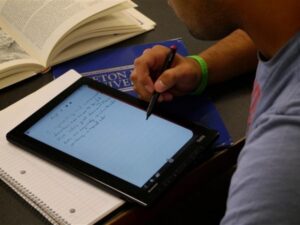Research Sightings: Writing with Tablets in Higher Ed

As the semester got underway this fall, you may have noticed an increase in the number of students in your classes who were working on tablets for reading texts, taking notes, and drafting assignments – when they weren’t sneaking a look at Instagram. I wondered aloud with both students and colleagues about the impact of tablets on thinking and writing, and my questions sent me searching for research on the topic.
In “Multidisciplinarity and the Tablet: A Study of Writing Practices” (2013), Jennifer Ahern-Dodson and Denise Comer, teacher-researchers at Duke University’s Thompson Writing Program, take up the question of how the tablet impacts both scholarly writing practices across disciplines, and practices in the teaching of writing itself. In a year-long study at Duke, the authors followed a group of 76 student tablet-users in 4 different courses (French, Environmental Science, Public Policy and Journalism, and First-year Writing and Composition), as well as 6 faculty members who met regularly in a community of practice.
Ahern-Dodson and Comer found that the tablet had important positive and negative impacts, depending on when it was used in the writing process, and in what disciplinary contexts. The tablets had a significantly positive impact on students using the device and its apps for reading, annotating, note-taking, short bursts of drafting, and data collection – all activities that we might describe as belonging to the generative, pre-writing phase of the writing process. Faculty too reacted positively to the tablet’s note-taking versatility, both for responding to student work and for designing assignments. For example, the French teachers loved the ability to micro-annotate student papers with both written and verbal remarks, while the public policy professor designed assignments based on the students’ ability to record interviews, create and collate field notes, and draft and post articles, all on the same device.
However, both students and faculty agreed that the tablet offered no advantages when it came to in-depth composing, and perhaps even impacted the writing process at this stage in a negative manner. Not surprisingly, both groups complained about the awkwardness of extended sessions of touch-screen typing, and the inadequacy of word processing apps. Arguably, both of these deficits may be symptoms of a technology still in its early stages of development: touch screens may improve rapidly (and users will soon be touch-screen natives and not adopters), and word processing apps will quickly evolve. It is still notable, however, that both faculty and students, after an extended period of use, strongly preferred their older laptop, desktop or even pen-and-paper tools over the tablet. The authors mention particularly the limits of the tablet in facilitating the iterative “movement from thought to text” (70); in other words, the reviewing, revising, reorganizing and deleting of chunks of text, when the big picture of an argument and its individual parts are coming into focus. In short, the tablet does not optimize, and may even interfere with, a critical late phase in the composition process.
Ahern-Dodds and Comer – who characterize themselves at the outset as committed to digital literacies and multimodal composition – nevertheless conclude by advising teachers to open a critical dialogue with students using tablets on the advantages and disadvantages they offer, both with respect to particular kinds of disciplinary learning activities, and with respect to the writing process.


